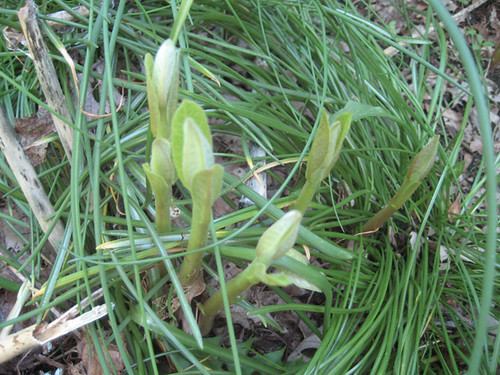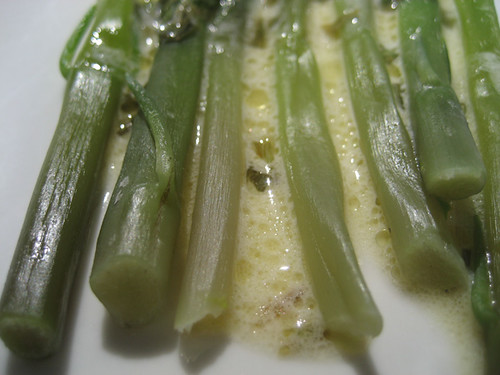Eat This Yard: Or Taking Food From the Mouths of Butterflies
Eat This Yard: Or Taking Food From the Mouths of Butterflies
-
-
-
-
-
Eat This Yard: Or Taking Food From the Mouths of Butterflies
-
Post #1 - May 18th, 2009, 1:07 pm

In my Sky Full of Bacon podcast Eat This City, urban forager Nance Klehm notes (starts at around 12:45) that milkweed shoots can be eaten something like asparagus, and that the pods, when very young, can be cooked like okra. But then she says she doesn't like to eat them, because they're the only food of the monarch butterfly, and she'd rather eat other things (since she can and they can't).
This notion piqued my curiosity, though, since I had milkweed growing in my somewhat neglected front yard patch last year. The kids and I had observed it in its various phases— and best of all, spotted the occasional monarch dining in our front yard. So the notion that monarchs needed it for their own food was by no means abstract— but at the same time, omnivorous foodie that I am, I couldn't help wonder what milkweed would taste like. Here we are in the season when ramps are all the rage, I could be the first on my block to try another bit of locally grown, wild flora.
So I went into my weedpatch of a front yard and examined the shoots. There were 6 or 8 clusters of about 4 to 6 shoots each. Surely I would not do any harm to simply thin the clusters out by one shoot each, they wouldn't all grow to butterfly-feeding maturity... right? That at least is what I told myself.
I came back inside with a fistful of young shoots, thin and tender, only a few leaves at the top, leaking sticky white sap from the cut end. Then I began looking up how to cook them. The news at first was very far from encouraging:Milkweed is typically found in dry habitats, especially in dry, disturbed areas like roadsides, pastures, and dry stream beds. Although eating milkweed is rarely fatal to humans (because it tastes nasty), livestock occasionally die from eating it. Young shoots of milkweed can be eaten, but only after thorough cooking. Never eat parts of mature plants. Milkweed sap can cause a rash on people with sensitive skin.
Then I found this, by a guy who'd not only eaten them without changing the water three times (as all the recipes recommended to rid them of bitterness and toxicity), he'd eaten them raw, and lived into his 70s to tell the tale:Eventually I tried milkweed shoots boiled without changing the water; furthermore, I made sure to begin the process with very cold water so I could “set” this elusive bitter principle just to see what it tasted like. (I had expended so much time, water, and cooking fuel to fight this chemical culprit that I was becoming anxious to meet him.) The result was perfectly delicious without even a hint of bitterness. I drank of the cooking water, too, and it tasted mild and pleasant, like green beans. After that I went out and ate a small quantity of milkweed shoots raw, and they were rather tasty. So then I tried the milky sap by itself - only to find that it was without any noticeable unpleasant flavor. It turned out that our bitter enemy was too much of a coward to even show up.
Who to believe on the internet? In the end, I took the small chance of following the recipes that said cook it for 15 minutes in the same water, no changes. Someone had to be the first to taste tomatoes, grapes, hemlock. I started the pot boiling and meanwhile, figuring that asparagus was the model here, I whipped up a simple butter-lemon-tarragon cream.
15 minutes later and, well, they were already so soft that it was hard to imagine how more cooking and more changes of water wouldn't have turned them to puree. I took them out and tasted one.
Yes, certainly asparagus-like, not quite as strong-suphurous... and a little sweet note which asparagus never has. Interesting enough to try once, little reason to want to make it a regular part of your spring diet. Which was a relief; had I found it wonderful, I would have had to ask myself whether it was ethical to call attention to eating milkweed in a way that might influence others to go out and start stripping fields of newly grown shoots.
Yet of course, the only reason I'm asking this question at all is because I happen to have a factoid about this one plant in my head. How many other times have I called attention to something delicious, heedless of the fact that today's foodie trends to watch list is tomorrow's endangered species watchlist? My clusters of ethics are clearly rooted in a vast field of locally grown, wild ignorance.
So take my word for it. Milkweed's okay if you're a native American during a slow bison season, but it's nothing to get excited enough about to make it worth taking from the mouths of butterflies. No particular need to add this one to the heavy list of sins we gluttons carry.
Although I am awfully curious about this:Wild Food Recipe: Sautéed Milkweed Pods and Mushrooms
In this recipe, I removed the immature seeds - the inner white part of the milkweed pod. I looked for young pods, which tend to be small, rough textured, and do not split open easily.
I wanted to see if cooking the insides of the pod would make it stringy, like cheese. In this case, I used white mushrooms, so I could focus on the milkweed. Watch Sky Full of Bacon, the Chicago food HD podcast!
Watch Sky Full of Bacon, the Chicago food HD podcast!
New episode: Soil, Corn, Cows and Cheese
Watch the Reader's James Beard Award-winning Key Ingredient here.

